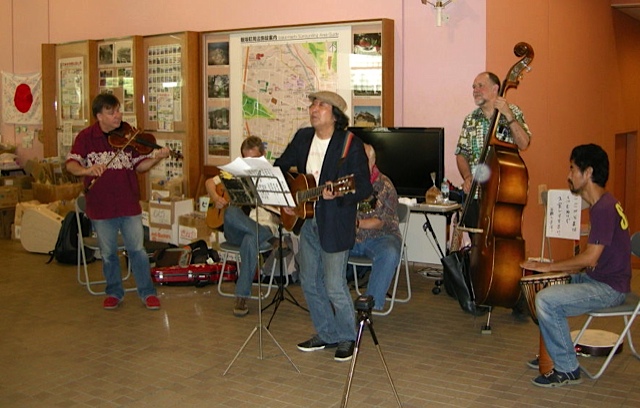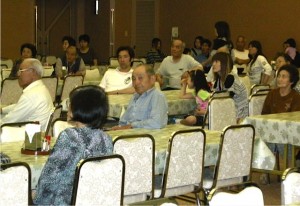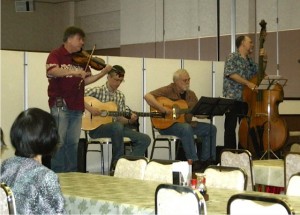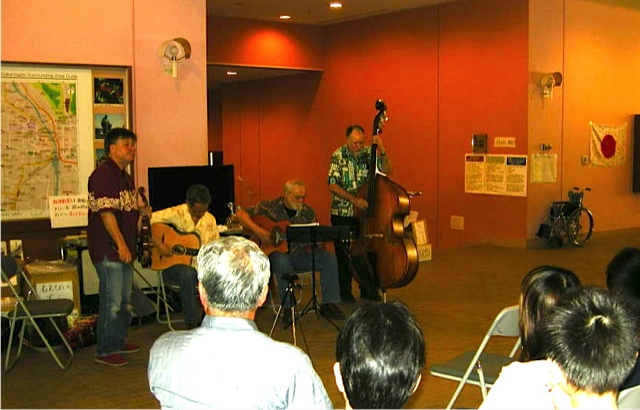A report from my friend Alan Gleason, an American expatriate living in Tokyo, about his recent visit to Japan’s earthquake zone with his hot jazz band, “The Hot Club of Osawa.”
 (That’s Alan, playing the stand-up bass)
(That’s Alan, playing the stand-up bass)
By Alan Gleason
I’m an American citizen and long-time Tokyo resident, work as a translator and editor for a living, and also play upright bass in jazz groups in my spare time. One of the groups I play in is a quartet of fellow-foreigners playing traditional “gypsy swing” jazz on violin, guitar and bass. The other members are all professors at International Christian University, located in Osawa, Mitaka city. It so happens I grew up in Osawa, too. So we call ourselves “Hot Club of Osawa”. The other members are Chris Hoskins (violin, USA), Matt Gillan (guitar, UK) and Bill Harshbarger (guitar, USA).
Two weeks after the March 11 earthquake we played a gig at a cafe in my neighborhood in Suginami, on the west side of Tokyo. Afterward a lady came up and introduced herself as a liaison between Suginami and the city of Minami-Soma, Fukushima, which is inside the nuclear no-go zone, just north of the crippled Fukushima reactors. Suginami and Minami-Soma have a sister-city relationship, it turns out. Minami-Soma citizens have been evacuated to various locales outside the no-go zone, but a large number of them are staying in the hot springs resort of Iizaka, just outside Fukushima city, the prefectural capital 60 km northwest of the nukes. The resort hotels have been paid by the government to house the evacuees. They have been there since mid-April (previously they were in makeshift shelters elsewhere) with no idea of when they will be able to leave or where they can go. Some lost their homes in the tsunami but many have homes that are intact but essentially abandoned in the radiated zone.
Our contact, Midori Watanabe, explained that she is organizing visits by musicians to the evacuation centers to entertain these folks, as well as volunteers providing massages. So our band agreed to drive up there on May 21 and 22 with a group of six massage volunteers. We played three gigs in three different evacuation venues (two hotels and a conference hall converted into an evacuation center), while the other volunteers provided massages in another room. Our band was also joined on stage by Tomo and Ryu, a guitar/vocal and percussion duo who sang original songs in Japanese.
The evacuees were clearly grateful for the entertainment, but it was also clear they were in low spirits overall. They ranged in age from very young to very old. The seniors smiled tentatively and clapped along with some of the more familiar tunes (we played a couple of popular Japanese chestnuts in addition to our usual American/European repertory). The middle-agers seemed the least enthusiastic, or maybe just bemused at these foreign entertainers who’d appeared out of nowhere.
The warmest response came from the young kids in the audience, who were delighted to encounter a bunch of weird looking guys carrying even weirder instruments. They swarmed us and asked all kinds of questions about the violin, guitars and bass, wanting to touch them and try playing them. During the concert some of the kids ran around the room playing tag, but others listened with rapt attention. It was clear they were going stir-crazy in their evacuation quarters, even in the nicely appointed resort hotels were many of them were staying.
 Many of the evacuees talked to us quite willingly about their plight and their concerns. Parents in particular are worried about their kids. With their situation so unsettled, they don’t know whether to enroll the kids in local schools, or to wait till they can resettle somewhere more permanently. And in the meantime, they are upset that radiation levels are still high enough, even in Fukushima city, that kids are not supposed to go outside to play in the parks and school playgrounds.
Many of the evacuees talked to us quite willingly about their plight and their concerns. Parents in particular are worried about their kids. With their situation so unsettled, they don’t know whether to enroll the kids in local schools, or to wait till they can resettle somewhere more permanently. And in the meantime, they are upset that radiation levels are still high enough, even in Fukushima city, that kids are not supposed to go outside to play in the parks and school playgrounds.
In its lovely riverside setting amid verdant hills, the resort town of Iizaka seemed like a nice enough place to be evacuated to. But in addition to the evacuees themselves, there were other reminders of the ongoing crisis on the coast. The hotel we stayed in housed about 200 evacuees but also an equal number of prefectural police squads from all over Japan, who had been brought in to help with the post-tsunami cleanup both inside and outside the nuclear no-go zone. Every evening they would return in a convoy of large police buses, masks on their faces, having worked all day out on the coast. I didn’t have a chance to ask them what sort of work they were doing, but from news reports one can assume it involves such onerous tasks as searching for bodies.
The evacuees received us very graciously and many expressed their gratitude to us for coming. For our part, we tried to stick to our role as cheerful entertainers without engaging in gratuitous exhortations to them to “cheer up” or “hang in there.” In fact, our coordinator had advised us to avoid well-intentioned words of encouragement, because the evacuees had heard it all and were sick and tired of being told by government bureaucrats and media personalities to “hang in there” (“Ganbaro!” in Japanese). 
In addition to emotional exhaustion, despair and anxiety, the evacuees also displayed anger and frustration, and didn’t hesitate to express it. They are angry at TEPCO for the nuclear disaster that has driven them from their homes, of course, but also at the government for failing to take active measures to minimize their (and especially their children’s) continued exposure to radiation in the aftermath. Particularly galling to them was the government’s arbitrary raising of the level of accepted radiation exposure for children to 20 millisieverts per year, over 20 times the internationally recognized maximum dose (click here for heartfelt appeal from the mothers of Fukushima).
In the end, it felt good to be doing something constructive, however trivial. Hope we can go up there again.

